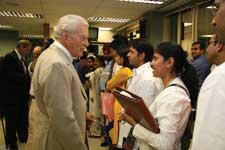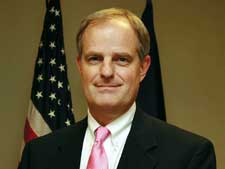Immigration
Visa Dawn

Peter Kaestner, Minister Counselor for Consular Affairs at the U.S. Embassy in New Delhi.
|
For the half million Indians who run the bureaucratic maze at U.S. consulates every year, U.S. Ambassador David C. Mulford’s announcement in October in New Delhi pledging to “reduce the waiting time for a visa appointment with the goal of eliminating this waiting period altogether,” was as startling as it was monumental.
Visa applicants, who typically waited for months on end for an appointment, are now greeted on the embassy’s website with the surprising greeting: “Visa appointments are now available in all categories.” Mulford explained: “Nothing is more important for the future of our two countries than the strong and growing bond of business and people-to-people contact. Strengthening these connections is the future of U.S.-Indian relations and we have begun this today.”
Ambassador Mulford’s comments have created quite the international buzz. Now that the commitment has been vocalized, how does the embassy plan to reduce and eventually eliminate the waiting time for visa appointments? It is a simple plan. Starting September 25, we put all available resources on the NIV (Non Immigrant Visa) line. In addition to the mission’s resources, the Department of State supported us both financially and with additional vice consuls. We have temporary duty officers in India from as far away as Bogota, Hermosillo, Tokyo, Hong Kong and London. Between September 25 and October 23 we increased our visa production 52 per cent. The backlog for appointments for non-immigrant visas has essentially been eliminated. There are appointments available all over India. Do these changes apply to immigrant and non-immigrant visas? The initial push was directed at the NIV appointment backlog. Now that we have NIV appointments available, we are also looking at our IV (Immigrant Visa) processing too. Early next year, we intend to examine all our interactions with the public with the intention to making them more efficient and customer friendly. Can you give us a sense of what the average waiting period was for the most common visa categories and what it is now? Certain IV categories, including Limited Family Based visas and H visas, have annual entry allowances. How will the revisions affect the wait times and/or number of allocations? The limitations that you hrefer to are congressionally mandated. Only a change in legislation will increase those numbers. Eliminating the backlog will allow all applicants, including those on numerically controlled visa categories, to get an interview more expeditiously. Are you also attempting to reduce the wait times for people who line up daily outside the consulates?
In the old days, people used to queue up outside the building to wait for a chance to see a consul. When we implemented our appointment system, the queue became an electronic, or virtual, wait. Unfortunately, because of the physical limitations of our buildings, increasing workload and security screening requirements, queues then developed as our clients waited to enter the consular office. In the past six weeks, we have eliminated the virtual wait, and Indian visa applicants can obtain visa appointments promptly. While that is great news, the processing to get into the section is still a concern. In the short term, we will be looking at further hrefining our processes to reduce the waiting for all our customers, and to reach a goal that all visa applicants be processed from start to finish in two hours or less. I believe that, since over a half million Indians approach the U.S. Government each year to request consular services, we have an important obligation to treat each and every customer with dignity, respect, and professionalism. In the coming months, we will be looking for tangible ways to further improve our services with this important thought in mind. In the medium-to-long term, we are building new facilities in Mumbai, Delhi, and Hyderabad and improving/expanding the sections Calcutta and Chennai. Within a year, Calcutta and Chennai should be ready to process more applicants more rapidly, and in 2008, we expect the other three major construction projects to be finished. Our intention is to make the visa applicant process as efficient and pleasant as possible. It is a very exciting time to be in India. Is there any correlation between the timing of these visa changes and the current immigration issues in the U.S.? No. It is just tied to a routine change in personnel. At my last post (Cairo), there was a four-month backlog when I arrived. Within six months, we had eliminated it. It was clear to me that eliminating the backlog would be job number one when I arrived in India. What made it so dramatic was the leadership and initiative of Ambassador Mulford. Without his commitment of all the Mission’s resources, we could never eliminate the NIV appointment backlog so quickly. We do not release our hrefusal rates in any country as a matter of policy. (Data on approvals in table). Of the applicants that reapply after being denied, what is the percentage of approved visas? What are the most common reasons visas are denied? Most non-immigrant visa denials are based on Section 214(b) of the Immigration and Nationality Act. This part of the law requires all applicants to demonstrate to the interviewing consular officer that they have a residence in a foreign country that they have no intention of abandoning. In other words, the burden of proof is on the applicant to show that they plan to go back to India after their temporary stay in the United States. Of the four U.S. consulates in India, which is the most difficult to oversee and why? What accounts for Chennai being the busiest consulate? In addition to wait times, one of the greatest complaints from visa applicants is that consular officers do not grant enough time during the appointment to fairly evaluate the petition. Some even say they are apathetic. How do you address these concerns? As Consul General, what is your greatest frustration with the visa process? We always hear the same advice for applicants: never forge documents and be honest with the consular officer about your past and the purpose of your visa. What other, atypical advice can you offer applicants?
The biggest challenge I faced was the non-immigrant visa (NIV) backlog. I had hoped to tackle it within a year, but Ambassador Mulford’s initiative has allowed us to marshal the resources of the entire Mission. As a result, we’ve already eliminated the backlog and appointments for non-immigrant visas are now available. In the weeks to come we’ll be fine-tuning our processes to identify and meet our on-going demand. From 1981-1982, you served your first overseas assignment with the State Department as a vice consul in New Delhi. How is it returning 24 years later? You entered the Foreign Service in 1981 and have been assigned to remarkable countries – Egypt, Brazil, Colombia, Guatemala, New Guinea, Malaysia, the Solomon Islands, and Namibia. Besides obvious cultural differences, what sets India apart from other countries? One of the things that most impressed me in 1981-2 was the extraordinary closeness of our peoples. Even during a time when our bilateral political relationship was not particularly warm, there was never a shortage of applicants in the visa line. Now, almost a quarter of a century later, the economic miracle that India is enjoying is partially built on those personal ties. While each company must make business decisions based on the bottom line, I believe that the investment and commitment to India by U.S. companies is strengthened because of those person-to-person ties that have sustained our relationship through the years. In your view, how have the economic transformations in India altered its traditional social landscape?
Funny you should ask me. I was just watching a Bollywood movie on the plane last night from Frankfurt. What struck me was the amazing resilience India has to social change. Imagine a U.S. movie in which not even a kiss is exchanged between the stars. While I marvel at the strength of the Indian culture, it also has its down sides. Unfortunate practices such as female foeticide and dowry killings have also shown unfortunate staying power. What are your concerns for India’s future? I understand you are an avid birder. By 1986, you were the first birder to see a representative of each bird family in the world, and in 1989 you discovered an entirely new species in Colombia. Any unusual bird sightings in India? So far I’ve been focusing mostly on work. I did get one new bird at Sultanpur shortly after I arrived. The Bristled Grassbird was so poorly known in 1981-2 that it was just about impossible to see. In the interim, a home-grown birding group in Delhi has developed, along with considerable expertise. This expertise helped me to see the grassbird in August. As Indians become more affluent, they are embracing leisure activities like birding. That is great. Back to my own plans, I hope to focus on the Northeast of India, since it was off-limits when I was here in 1981-2. I am especially looking forward to visiting Eaglenest Wildlife Sanctuary to see the newly described Bugun Liocichla. Ok, I have to ask: what is your favorite Indian food? Finally, what has been your most profound Indian experience?
My most profound memories all revolve around nature. I still have haunting memories of sleeping on the roof of our house at K-80-A Hauz Khas in 1967. As I slept on the barsati, I could hear the peacocks’ mournful calling off in the distance – a wonderful sound. It was a reminder that we were living in a wild area, on the far southern reaches of Delhi. Another magical moment was in Corbett Park in 1982. I was looking for the Indian Pitta, which was a new family for me at the time. Walking alone through the forest, I suddenly came upon a huge bull elephant. I still cannot understand how you can suddenly come upon such a beast, but I did. The tusker trumpeted to voice his displeasure, raising his trunk and flapping his ears at me. I was scared to death, but in an instant, he turned and walked away, not interested in squashing me flat as he easily could have done. The thrill of such an encounter still makes me shiver! I believe that being in touch with nature helps us maintain our humanity and better understand our place in the world. |





